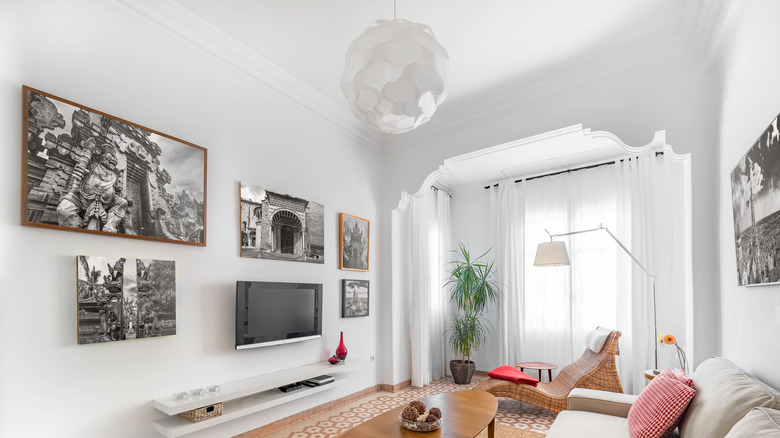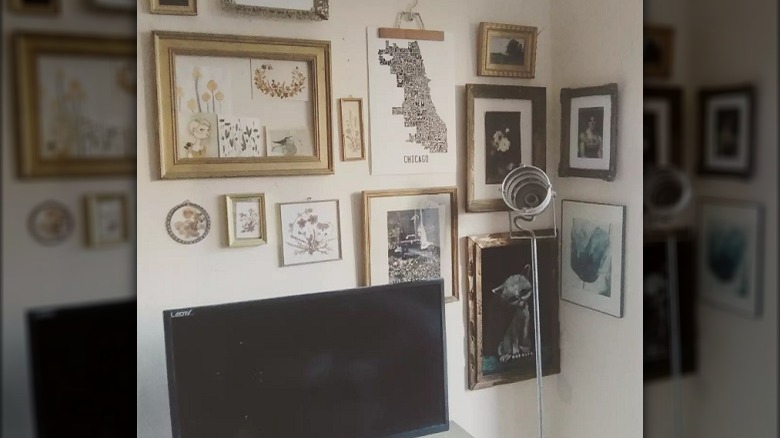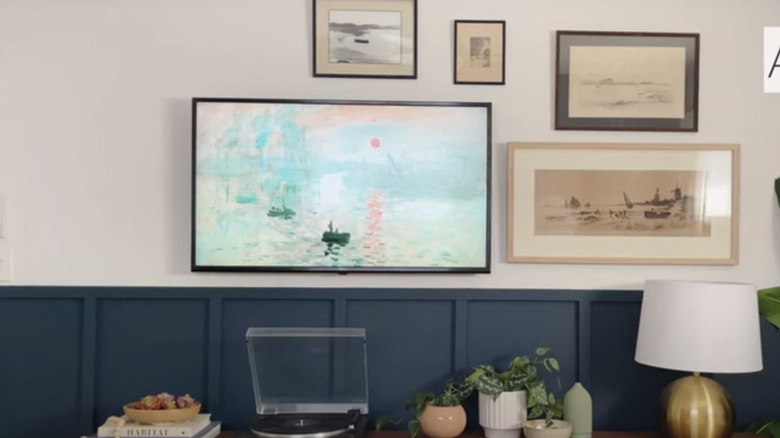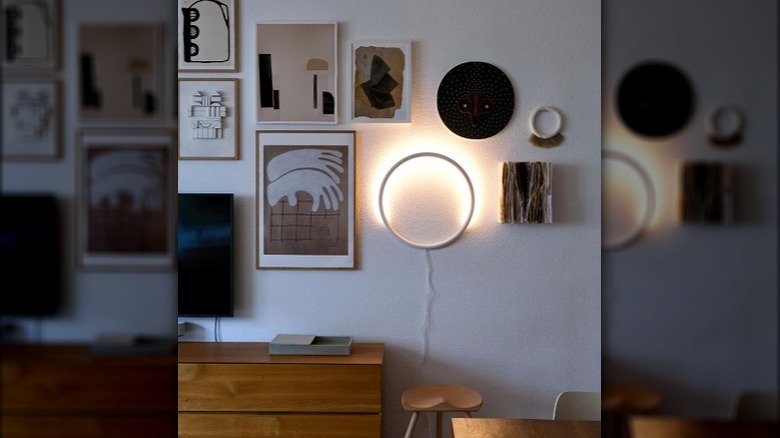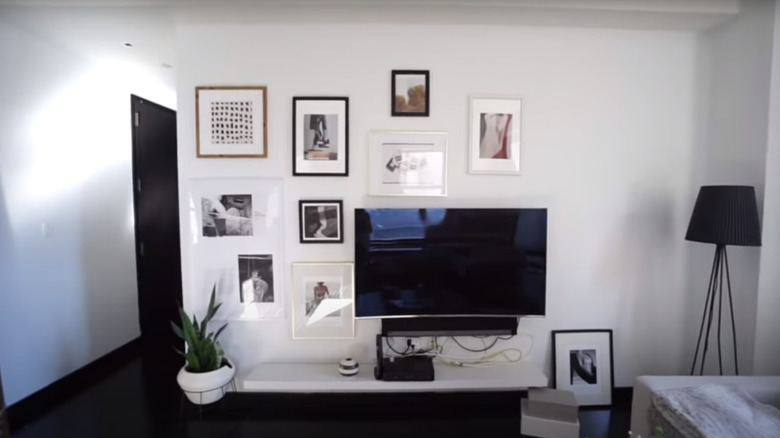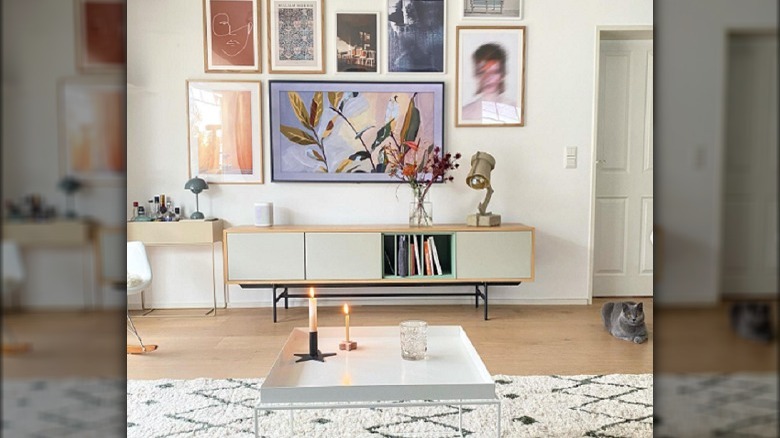5 Tips For Building A Gallery Wall Around Your Television
Televisions are often a necessary evil in many living spaces, much in demand, but never as pretty or décor friendly as we would like. While many can tuck their sets and related equipment behind the walls of a cabinet or carefully conceal them in another piece of furniture, some spaces require a little more ingenuity. A gallery wall above and around a television set or desk monitor is a brilliant way to disguise and blend the black box into a harmonious part of your room design.
Creating the perfect gallery wall surround for your TV is an art of scale and balance, which can be tricky. We've outlined a few key things to think about as you begin to collect, prepare, and hang your gallery wall that will help integrate the TV seamlessly into your décor. Whether your style is more traditional and formal or eclectic and casual, the gallery wall approach to disguising your TV works wonders to keep the set incognito when not in use but readily accessible when you want to kick back and watch it.
Choosing art
Gallery walls around the television are a great place to display eclectic collections of art or more deliberate, intentional groupings of similar or like pieces. You can show off small pieces of art that may be underwhelming on larger, blank walls. By hanging them together, the gallery wall is a way to create a grouping and assemblage of individual pieces to create a much grander effect.
If you like the idea of more diverse groupings, feel free to include artwork in a number of formats, including graphic posters, photographs, sketches, and paintings. Three-dimensional objects are also an excellent way to add texture and dimension to the wall above a media console. These can be textile pieces, framed botanicals, wall sculptures, mirrors, and sconces. Variations in shape will add more interest, so consider grouping small pieces in shapes like ovals, circles, hearts, and right-angled pieces. Use different sizes of artwork to play with scale and dimension when balancing surrounding pieces with a large television.
Color and composition
Gallery walls work beautifully to tie in colors and materials throughout the rest of the room. The wall above a television filled with framed pieces can do this as well, reflecting different aspects of a room's décor and style. Here, a grouping of vintage nautical photographs and a pastel framed TV painting reflects the shades and materials on the media console, including notes of brass, green, and terracotta. Their sea-faring subject matter complements the navy wall panels below, amplifying the nautical design scheme in the room. If the palette is more limited, you can repeat desired colors throughout the selections.
Use your gallery wall to tie in colors and materials found elsewhere, like lamps, pillows, and rugs. This can be accomplished through colors in the artwork itself or the color of the frame or matting. If your television is a black rectangle, you can also use additional black pieces of art, frames, or mats to draw the eye equally between the elements, which helps to make the grouping more cohesive.
Frames and presentation
While material, color, and style variations can be stunning in casual and informal aesthetics, a more uniformly designed gallery wall is a good fit for traditional or formal rooms. Frames are an ideal way to add uniformity in size and materials, even with disparate art, particularly when hung in a grid format. You can also use the same or similar frames in varying sizes and orientations to achieve a more cohesive look, as shown in the image above.
An array of frames and materials complements more eclectic styles like cottagecore and boho décor. In these styles, you can mix together more opulent gilt frames with simpler black and wood ones, painted canvases, scroll frames, or no frames at all. If you are looking to add some more white space to your wall, try hanging empty decorative frames between other elements or interspersing three-dimensional pieces like wall sconces, planters, or shadowboxes throughout.
Layout
The space around a television offers a number of ways to approach laying out a gallery wall. While artwork is traditionally hung either directly above or off to the sides of a large television, gallery walls offer much more flexibility in placement, size, and scale of installation. Here, a selection of artwork enfolds the TV set on one side and tapers down to the low-slung media console, making the TV part of the grouping and much less the focus of the wall.
The room's needs will determine what looks best for shaping and scaling the gallery wall. Larger and higher spaces often allow a bit more room between pieces, with smaller areas requiring fewer pieces closer together. It's incredibly helpful to figure out where things go before you start hanging artwork on the wall. Paper cuts assembled on the wall with tape are essential for plotting where things go.
Frame TVs
One of the most popular current design trends are frame TVs, made to look like slender pieces of wall art that can be customized to show different art pieces with the click of a button. These frames, which come in a variety of wood and metallic finishes, sit flush with the wall and are mostly indistinguishable from surrounding framed artwork when not playing. There are also a number of tutorials online for building a frame for an existing television, which works nicely for slimmer wall-mounted sets.
Even if your set rests on a traditional media console, several smart TVs have the option to display artwork or decorative wallpaper in lieu of the usual black screen, making the set much more inconspicuous, particularly when paired with a surrounding gallery wall. Inexpensive fabric screen dust covers also come in many artistic designs, including landscapes and famous classic paintings like Van Gogh's "Almond Blossoms."
